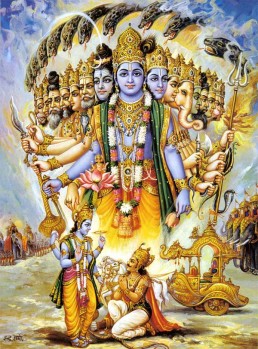Swami Chinmayananda
Swami Chinmayananda Commentary
We have already explained how it is relatively easy to see the essential stuff as the core of individual names and forms, but the reverse of it — to discover the many in the one — is the work of a subtle intellect functioning through right philosophical understanding. TO READ a poem, only a knowledge of the alphabet is necessary; but to understand its subtler beauties and to classify it in a comparative study with other similar poems, it needs a masterly mind that has been well soaked with the master-pieces in poetry. Similarly, to see “THE ONE IN THE MANY” is the work of a ‘heart’ soaked with faith; but to PERCEIVE “THE MANY IN THE ONE,” we need, besides the ‘heart,’ an educated ‘intellect’ that has learnt to see for itself the logic of the philosophers. This peculiar capacity of an educated intellect to see the extraordinary is the vision of the intellect which is gained when we develop the faculty to perceive and to know.
This obvious fact is explained by the Lord in this stanza, “YOU CANNOT SEE ME WITH THESE EYES OF YOURS; I GIVE THEE THE VISION DIVINE.” There are very many critics who try to explain this “Divine-eye” through fantastic suppositions and ridiculous theories. Such commentators are certainly men, not much educated in the style of the Hindu scriptures, the Upanishads. Expressly and tacitly, all through the Upanishads, it is repeatedly explained that the subtler cannot be brought within the scope and compass of the instruments-of-perception given to man. The external sense organs can play freely only in the outer world-of-objects. Even when we ordinarily “see an idea” it is not done with our outer pair of eyes. The intellectual comprehension is meant here by the term “seeing” and the capacity of the intellect to comprehend is the ‘Divine-eye.’
This “special-vision” is given to the Pandava Prince so that he may see “MY SUPREME YOGA-POWER” by which the whole Universe of multiplicity is being supported by the Lord’s own form. Earlier, this particular Yoga-Power of the Lord, has been already described at two different places, (VII-12 and IX-4) almost in identical terms.
THE SCENE SHIFTS TO HASTINAPURA, IN THE PALACE OF DHRITARASHTRA:
Adi Sankara Commentary
Tu, but; na sakyase, you are not able; drastum, to see; mam, Me, who have assumed the Cosmic form; eva, merely; anena, with this natural; sva-caksusa, eye of yours. However, dadami, I grant; te, you; the divyam, supernatural; caksuh, eye, by which supernatural eye you shall be able to see Pasya, behold with that; me, My, God’s aisvaram, divine; yogam, Yoga, i.e. the superabundance of the power of Yoga [The power of accomplishing the impossible.-M.S.].
The Bhagavad Gita with the commentary of Sri Sankaracharya – Translated by Alladi Mahadeva Sastry
Holy Geeta – Commentary by Swami Chinmayananda
The Bhagavad Gita by Eknath Easwaran – Best selling translation of the Bhagavad Gita
The Bhagavad Gita – Translation and Commentary by Swami Sivananda
Bhagavad Gita – Translation and Commentary by Bhaktivedanta Swami Prabupadha
Srimad Bhagavad Gita Chapter 11 – Verse 8 – 11.8 na tu mam sakyase – All Bhagavad Gita (Geeta) Verses in Sanskrit, English, Transliteration, Word Meaning, Translation, Audio, Shankara Bhashya, Adi Sankaracharya Commentary and Links to Videos by Swami Chinmayananda and others – 11-8

